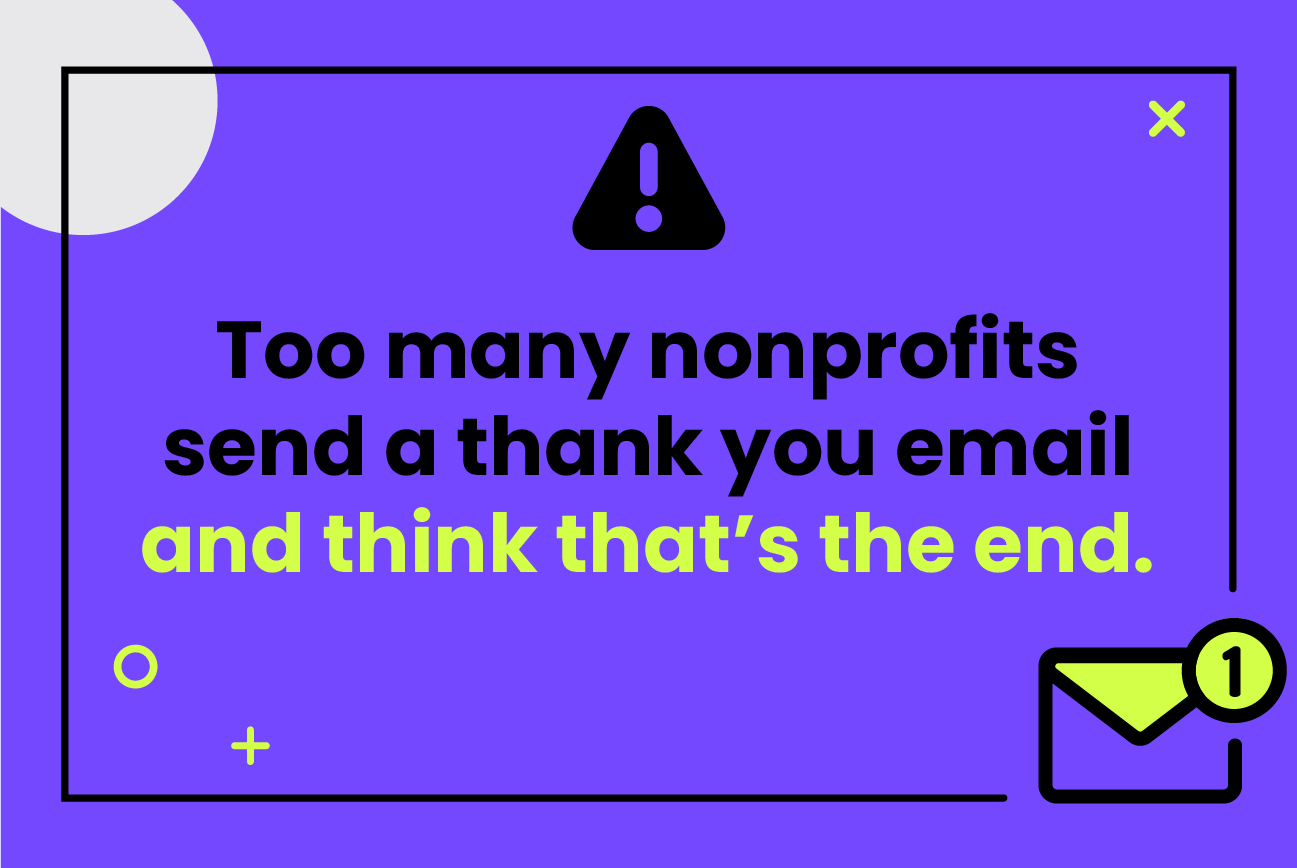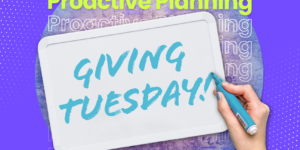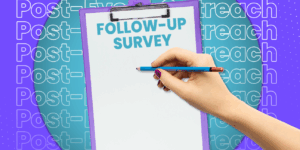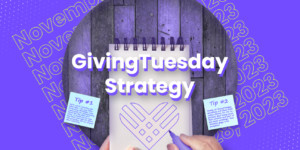The past few weeks have been a little chaotic, haven’t they? We’re sure you’ve been busy, between developing your Giving Tuesday strategy and preparing for your year-end appeal. But you still need to engage donors when the dust settles after Giving Tuesday. So resist the urge to take your foot off the gas!
I hate to be the one to remind you, but there’s less than a month between Giving Tuesday and New Year’s Eve! You might be tempted to take a week to breathe, collect yourself, and get ready for the big end-of-year push.
But that would be a huge mistake! You’re not out of the woods yet. You need a thorough and effective plan to engage donors after Giving Tuesday if you want to have a lasting impression!
Of course, we’re going to start by thanking those who donated on Giving Tuesday. But too many nonprofits send that thank you email and think that’s the end! Wrong!

Reach out to segmented audiences.
First thing’s first. You need to promptly thank the donors who helped make Giving Tuesday such a success for your organization.
But everyone shouldn’t receive the same message. Giving Tuesday brings in a lot of new donors. You will need to do more than say “thank you” if this first time you’re reaching out to someone directly!
If you have their email, send first-time donors a digital version of your new donor welcome package and thank them for joining your movement.
You can also ask them questions like “how did you hear about our organization?” and “What inspired you to give on Giving Tuesday?” to get a better understanding of your new audience.
If you’re feeling bold, you can ask if they would prefer to receive a emails or direct mail.
But don’t forget your current and long-time donors!
Remind them about the continued impact they have on your mission when thanking them after Giving Tuesday. Let them know you value their continued support and thank them for helping spread the word about your cause.
Finally, a third segment can consist of established donors who did not participate on Giving Tuesday. Reach out to engage these donors and let them know you missed their contribution. Remind them it’s not too late to make a difference this year and ask them to keep their eyes out for your year-end appeal (or just add another donate button in the email).

Brag about what they’ve helped you accomplish.
Reporting your success on Giving Tuesday is a double-edged sword. Your donors certainly care about your success, but you need to tell them in a way that gets them excited about your work! A number alone cannot do that.
So instead of announcing your fundraising totals after Giving Tuesday, show them why the money you raised is so important to your mission.
For example, rather than, “We raised $5,000 this Giving Tuesday,” you can say, “We raised $5,000, enough to buy 200 toys so children in poverty have a present to open this holiday season.”
And don’t overlook other numbers that might interest donors more than a fundraising total. For example, let your audience know how many people donated on Giving Tuesday. This can be especially powerful if you had many more donors this year than last!
Reporting numbers about how many donors gave, not what they donated, helps everyone feel like a part of your community. It shows them that every gift matters and others think your cause is worth supporting too!
Get active on social media.
Giving Tuesday is a social media phenomenon. So, your social channels shouldn’t go quiet after Giving Tuesday!
If you ran an effective Giving Tuesday social media campaign, you probably picked up a lot of new followers. Your posts got these people so excited that they donated and wanted to keep up with your nonprofit’s activities online.
So, don’t disappoint them! Your social media strategy needs to continue engaging donors after Giving Tuesday if you want to build relationships with your new followers!
Remember, you won’t get much information about someone from a page like. And if they gave through Facebook or another third-party, you might not have collected any information about them.
Also, a page like or follow isn’t permission to engage donors with appeals and other communications, even if you can find their email address!
So, make sure you post frequently on your social channels after Giving Tuesday. Post content like infographics that explain how donations further your goals, or pictures of those who benefit from your work.
You can also use social media to get more information about your new audience.
Consider posting lead generating content, like petitions or monthly impact e-newsletters, to secure email addresses and permission to engage donors on social media more directly.
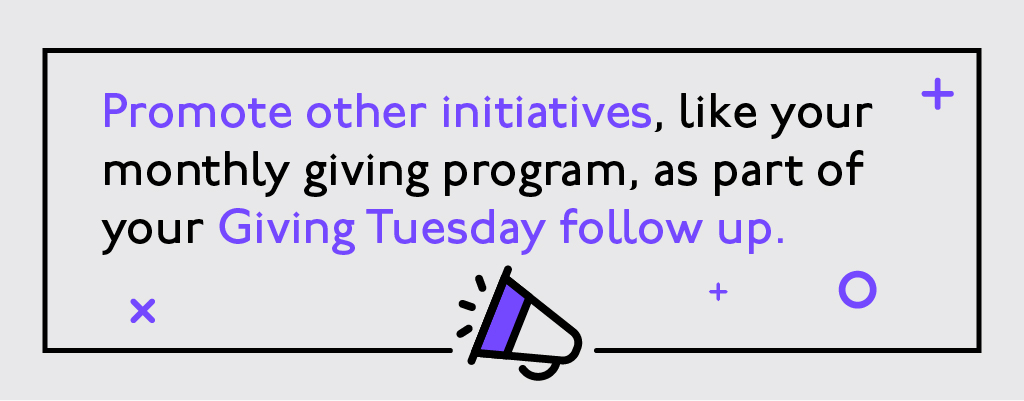
Promote other initiatives.
Your year-end appeal is a great way to tie Giving Tuesday into your over-arching fundraising strategy. This approach is especially powerful if you take our advice above about segmenting audiences when engaging donors after Giving Tuesday!
Start by segmenting your donor base into two groups, those who gave on Giving Tuesday, and those who did not.
Warm donors up for your year-end appeal when you follow up after Giving Tuesday. Thank donors who gave participated and let them know how they can further their impact with another gift at the year’s end.
Then, prep those who didn’t contribute on Giving Tuesday for your upcoming appeal. Show them what your organization is accomplishing because of the support you received. Then, let them know it’s not too late to make a difference! Remind them that your year-end appeal is coming soon and explain why you need their help!
You can take a similar approach with your monthly giving program. For example, consider creating a segment for donors who gave less than $20 on Giving Tuesday. Ask them if they would like to make that donation their first monthly gift when you follow up after Giving Tuesday.
It’s crucial to outline the benefits of monthly giving when you engage these donors. Explain how monthly donations sustain the impact of your initiatives year-round. And let them know why other donors prefer to give small monthly donations, rather than one or two large contributions a year.
WATCH: Webinar Recording: A Discussion on Your 2020 Year-End Fundraising
It’s not one day of giving.
We won’t lie to you.
There is going to be a lot of noise on Giving Tuesday. And it can be difficult to rise above it if you don’t have a comprehensive outreach strategy! After all, donors probably got an email from every organization they’ve ever engaged with on December 1.
But most of those organizations focus on raising the most they can in a single day. Nonprofits that see Giving Tuesday as a one-and-done event generally don’t have a great plan to engage donors with their follow up!
Sure, they will reach out to say, “thank you.” But there probably won’t be much more to it. They probably won’t reach out to current donors who did not donate on Giving Tuesday until they send that year-end appeal.
So, this is your time to shine!
There will be a very brief quiet period for donors between Giving Tuesday and the end-of-year push. You can take advantage of this quiet time to set your organization apart, while laying the foundation for building strong relationships with your new audience.

